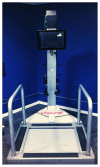Evaluation of Repetitive Jumping Intensity on the Digi-Jump Machine
- PMID: 32922627
- PMCID: PMC7449324
- DOI: 10.70252/WPMP5316
Evaluation of Repetitive Jumping Intensity on the Digi-Jump Machine
Abstract
Cardiorespiratory endurance is an important element of aerobic fitness, particularly in weight management and reducing risk for cardiovascular disease. While there are numerous options for aerobic exercise, rope jumping is often overlooked. In addition to regular exercise and a healthy diet, the American Heart Association strongly recommends rope jumping. The first purpose of this study was to determine the steady state metabolic cost of repetitive jumping on the Digi-Jump machine to evaluate whether exercise on this device is more or less strenuous than similar exercise with a jump rope, as demonstrated in previous literature. A second purpose was to determine the relative intensity of exercise on the Digi-Jump by comparing to VO2max as measured on a treadmill. Twenty-seven participants completed two trials, one jumping trial at a rate of 120 jumps per minute with the jumping height set at 0.5 inch for 5-min on the Digi-Jump, and one graded exercise test using the Bruce protocol. Oxygen uptake (VO2), heart rate (HR), respiratory exchange ratio (RER), and rating of perceived exertion (RPE) were measured each minute during each trial. Results of this study indicated that steady state VO2 during the 5-min jump test was reached at the 3rd min. Steady state variables during the jumping trial expressed as percentage of max were as follows: VO2 was 57.1% of VO2max; HR was 80.9% of HRmax; RER was 86%of RERmax; and RPE was 75.2% of RPEmax. These data indicate that repetitive jumping is a strenuous activity and similar in intensity to jumping rope, even if the trial is done on the Digi-Jump machine with free-swinging arms and without a jump rope.
Keywords: Cardiorespiratory; aerobic; cadence; steady state.
Figures
Similar articles
-
Effects of Different Surfaces on Metabolic Cost During Repetitive Jumping: A Pilot Study.Int J Exerc Sci. 2023 Jul 1;16(2):866-874. doi: 10.70252/MBDQ5711. eCollection 2023. Int J Exerc Sci. 2023. PMID: 37635918 Free PMC article.
-
Evaluation of Metabolic Stress between Jumping at Different Cadences on the Digi-Jump Machine.Int J Exerc Sci. 2010 Oct 15;3(4):233-238. doi: 10.70252/VJMR6012. eCollection 2010. Int J Exerc Sci. 2010. PMID: 27182351 Free PMC article.
-
Test-Retest Reliability of the Digijump Machine.Int J Exerc Sci. 2008 Jul 15;1(3):106-112. doi: 10.70252/EIAZ1106. eCollection 2008. Int J Exerc Sci. 2008. PMID: 27182301 Free PMC article.
-
Cardiorespiratory Parameters Comparison Between Incremental Protocols Performed in Aquatic and Land Environments by Healthy Individuals: A Systematic Review and Meta-Analysis.Sports Med. 2022 Sep;52(9):2247-2270. doi: 10.1007/s40279-022-01687-y. Epub 2022 Apr 29. Sports Med. 2022. PMID: 35486373
-
Jumping Rope Improves the Physical Fitness of Preadolescents Aged 10-12 Years: A Meta-Analysis.J Sports Sci Med. 2023 Jun 1;22(2):367-380. doi: 10.52082/jssm.2023.367. eCollection 2023 Jun. J Sports Sci Med. 2023. PMID: 37293420 Free PMC article.
Cited by
-
A Systematic Review with Meta-Analysis on the Effects of Plyometric-Jump Training on the Physical Fitness of Combat Sport Athletes.Sports (Basel). 2023 Jan 30;11(2):33. doi: 10.3390/sports11020033. Sports (Basel). 2023. PMID: 36828318 Free PMC article. Review.
-
Effects of Plyometric Jump Training on Measures of Physical Fitness and Sport-Specific Performance of Water Sports Athletes: A Systematic Review with Meta-analysis.Sports Med Open. 2022 Aug 29;8(1):108. doi: 10.1186/s40798-022-00502-2. Sports Med Open. 2022. PMID: 36036301 Free PMC article.
-
Effects of Different Surfaces on Metabolic Cost During Repetitive Jumping: A Pilot Study.Int J Exerc Sci. 2023 Jul 1;16(2):866-874. doi: 10.70252/MBDQ5711. eCollection 2023. Int J Exerc Sci. 2023. PMID: 37635918 Free PMC article.
References
-
- American College of Sports Medicine. ACSM’s Guidelines for Exercise Testing and Prescription. 10th ed. Philadelphia: Lippincott Williams & Wilkins; 2018.
-
- American Heart Association. Jump rope for heart guidelines. Dallas: American Heart Association; 1989.
-
- Barstow TJ. Characterization of VO2 kinetics during heavy exercise. Med Sci Sports Exerc. 1994;26(11):1327–34. - PubMed
-
- Borg G. Perceived exertion as an indicator of somatic stress. Scand J Rehabil Med. 1970;2(2):92–98. - PubMed
-
- Bruce RA, Kusumi F, Hosmer D. Maximal oxygen intake and nomographic assessment of functional aerobic impairment in cardiovascular disease. Am Heart J. 1973;85(4):546–562. - PubMed
LinkOut - more resources
Full Text Sources
Miscellaneous


